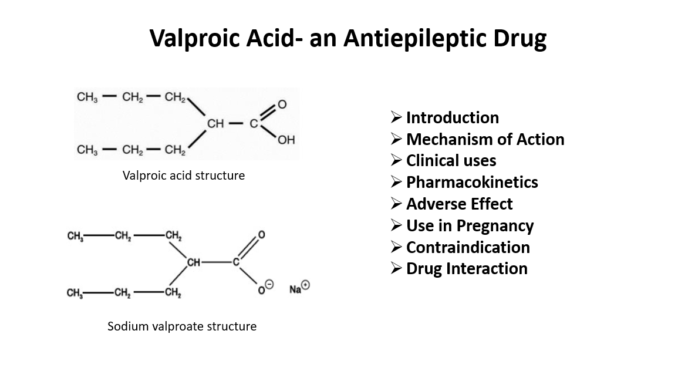
- Valproic acid and its other forms sodium valproate, semi sodium valproate and valproate are broad-spectrum antiepileptic drug effective in both generalized and partial seizures.
- Valproic acid is a weak organic acid. Its conjugate base is valproate. The sodium salt of acid is sodium valproate and coordination complex of two is known as semi sodium valproate.
- Valproic acid is short chain fatty acid synthesized in 1882, as an analogue of valeric acid (present in species Valeriana officinalis). It came into medical use in 1962 after Pierre Eymard and his team used it as solvent with potential anticonvulsant drugs. In all the solutions containing valproic acid, strong anticonvulsant activity was observed which lead Peirre and his team to study its antiepileptic activity.
- It is on the WHO (World Health Organization) list of essential medicines. It is also available as generic medicine and had become one of the commonly prescribed antiepileptic drug.
Mechanism of action of Valproic acid
- Its exact mechanism of action is not clear. It is supposed to act as multiple sites.
- It acts by:
- Delaying recovery of inactivated Na+ channels.
- Inhibiting T type Ca++ current.
- Inhibiting GABA transaminase resulting in increased GABA activity.
Clinical Uses of Valproic acid
- Effective in treatment of absence, myoclonic, partial and tonic-clonic seizures.
- Effective in combined grandma and petitmal seizures.
- As prophylactic in febrile convulsion.
- In manic depressive psychosis.
- In migraine prophylaxis.
- Due to its histone-deacetylase-inhibiting effect, its use in treatment of AIDs and cancer has been tested.
Pharmacokinetics of valproic acid
- It is absorbed completely and rapidly after oral administration. Peak plasma concentration reaches in plasma is attained in 1–4 hours, or several hours later if the drug is administered in enteric-coated tablets or ingested with meals
- Valproate extensively binds to plasma proteins, mainly albumin.
- It is entirely metabolized in liver by 5 metabolic pathways; mitochondrial b-oxidation, microsomal w- and (w-1)-hydroxylation, glucuronidation and other minor conjugation reactions.
- It is mainly excreted through urine with trace amount in bile and feces. Less than 3 % is excreted unchanged into urine.
Adverse Effects
- It is well tolerated by majority of patients.
- Most common side effects are GI symptoms including nausea, vomiting and anorexia. Long term treatment may increase appetite and cause weight gain.
- It causes sedation, ataxia, incoordination rarely. These effects disappear with decrease in dosage.
- Its major serious effect is hepatoxicity. Young children may be at high risk because of immature hepatic function. It is recommended to do baseline hepatic studies before starting valproic acid therapy.
- It inhibits platelet aggregation. Chronic administration may cause fatal hemorrhagic pancreatitis, bone marrow suppression and encephalopathy.
Valproic acid has black box warning for hepatotoxicity, pancreatitis and fetal abnormalities.
Use in pregnancy

- It possesses teratogenic effect. Exposure in pregnancy is associated with three-fold increase in rate of fetal abnormality. The valproate syndrome includes spinal bifida (birth defect when spine and spinal cord is not formed properly) mainly and rarely cardiac, skeletal and limb defects and anencephaly (NTD). Facial feature which tend to evolve with age includes triangle shaped forehead, medical deficiency of eyebrows, long upper lip, thick lower lip, broad nasal root and small downturned mouth.
- In children with valproate syndrome, increase in developmental problems, decreased verbal intelligence and communication problems are also observed.
- Use of other antiepileptic drugs potentiate the teratogenic effect of valproic acid.
- It is recommended for women who intend to become pregnant to switch to other antiepileptic drugs if possible. If not possible, lowest possible dose should be prescribed in 2-3 divided doses as monotherapy.
- Women who are taking valproic acid in pregnancy should be given periconceptional folic acid and followed up in high risk pregnancy clinic. Appropriate ultrasonographic and other examinations should be carried out.
Contraindications
- It is contraindicated in;
- Hepatotoxicity.
- If patient is allergic to valproic acid.
- Pancreatitis.
- Mitochondrial disease.
- Pre-existing acute or chronic liver dysfunction and family history of hepatitis (medicine related).
Drug Interactions
- It inhibits CYP2C9 and glucuronyl transferase so inhibits metabolism of drugs like phenytoin and phenobarbital, lamotrigine and lorazepam.
- It may potentiate CNS depressant effects of alcohol.
References
- Jaeri S, Islamiyah WR. The potential mechanisms of effect of valproic acid on lipid profiles: an updated review. Journal of Epileptology. 26(1-2): 49-54.
- Ximenes JCM, Verde ECL, Mazzacoratti MGN, Viana GSB. Valproic Acid, a Drug with Multiple Molecular Targets Related to Its Potential Neuroprotective Action. Neuroscience & Medicine. 2012; 3: 107-123.
- Silva MFB, Aires CCP, Luis PBM, Ruiter JPN, IJlst L, Duran M, Wanders JA et al. Valproic acid metabolism and its effects on mitochondrial fatty acid oxidation: A review. J Inherit Metab Dis. 2008; 31: 205–216.
- Methaneethorn J. A systematic review of population pharmacokinetics of valproic acid. Br J Clin Pharmacol. 2018; 84(5): 816–834.
- Ornoy A. Valproic Acid in Pregnancy: How Much Are We Endangering the Embryo and Fetus? Reprod Toxicol. 2009; 28(1): 1-10.
- https://en.wikipedia.org/wiki/Valproate
- Pharmacology and pharmacotherapeutics. 24th edition.
- Goodman and Gillman’s Manual of Pharmacology.